Jennifer Bohnhoff's Blog, page 43
March 15, 2016
In the Footsteps of heroes
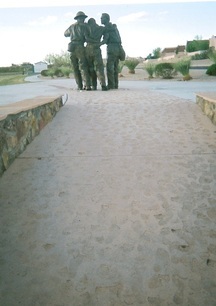 When New Mexico’s National Guard 200th and 515th Coast Artillery landed in the Philippines in the early 1940s, they thought they’d landed in paradise. Coming from an arid, landlocked state, few had ever seen beaches or tropical forests. Little did they know that it would soon become hell on earth.
When New Mexico’s National Guard 200th and 515th Coast Artillery landed in the Philippines in the early 1940s, they thought they’d landed in paradise. Coming from an arid, landlocked state, few had ever seen beaches or tropical forests. Little did they know that it would soon become hell on earth. On the day after Japan bombed the U.S. naval base at Pearl Harbor, December 7, 1941, the Japanese invaded the Philippines. They captured the capital, Manila, in less than a month. American and Filipino defenders retreated onto the Bataan Peninsula, where they held out for three months despite dwindling supplies of food, medicine and ammunition and no support or resupply by naval or air forces. By April 9, starvation and disease had become so crippled the troops that the force of approximately 75,000 surrendered.
The Japanese rounded up the surrendered soldiers and forced them to march some 65 miles in what became known as the Bataan Death March. The men, divided into groups of approximately 100, typically took around five days to march from the southern end of the Bataan Peninsula, to San Fernando where they were loaded in to cattle cars to complete the journey to prisoner-of-war camps. Exact figures are unknown, but it is believed that thousands of troops died because of the brutality of their captors, who starved and beat the marchers, and bayoneted those too weak to walk. More than 1,400 of those involved in the march were New Mexicans.
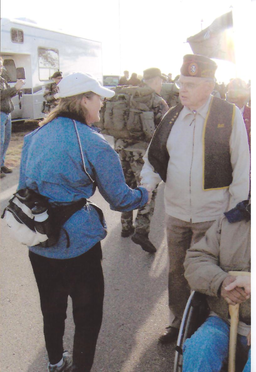 Shaking the hand of Bataan survivor William Overmeier, 2007 The Bataan Memorial Death March is a commemoration held every spring at White Sands Missile Range in Southern New Mexico. Marchers, many of whom are members of the military, complete either the 26.2-mile or the 14.2 mile course. Some carry heavy packs. All do it to honor those involved in the original march. Although their numbers are dwindling, some survivors attend this event. Now in their 90s, time is accomplishing what their Japanese captors could not.
Shaking the hand of Bataan survivor William Overmeier, 2007 The Bataan Memorial Death March is a commemoration held every spring at White Sands Missile Range in Southern New Mexico. Marchers, many of whom are members of the military, complete either the 26.2-mile or the 14.2 mile course. Some carry heavy packs. All do it to honor those involved in the original march. Although their numbers are dwindling, some survivors attend this event. Now in their 90s, time is accomplishing what their Japanese captors could not. I have done the march five times before: twice completing the short course and three times completing the long. I've accompanied friends, family members, Boy Scouts, and members of Team RWB, an organization that uses exercise and social activities to help veterans reintegrate into civilian life. This year the march is on March 20. This time I have trained and am leading ten others, including four 8th graders, their parents, and other staff members from the middle school at which I work. Five of us are doing the full course. Another six (including me) will complete the short course.
I’ll let you know how it goes.
Published on March 15, 2016 19:31
February 23, 2016
Where Ideas Come From
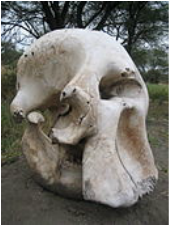 Photo by Ryan Junell via Wikimedia Commons My story ideas can come from some pretty interesting places. Once they enter my brain, they often transform themselves into something else entirely.
Photo by Ryan Junell via Wikimedia Commons My story ideas can come from some pretty interesting places. Once they enter my brain, they often transform themselves into something else entirely.Take, for instance, the original idea behind my young adult novel Swan Song. Who would'a thunk that a children's picture book would have inspired me to write a book about an Old English Epic?
 It all began with a book about elephants.
It all began with a book about elephants.It was part of a series of books that came, by subscription, through the mail.
My sons loved all the Zoobooks titles, and we read them over and over until the copies were as pliable and wrinkled as crepe paper.
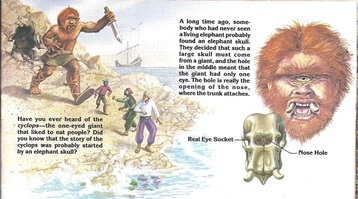 from Zoobooks: Elephants, copyright 1986 by Wildlife Education, Ltd. The Zoobook on elephants asked an intriguing question: "Did you know that the story of the cyclops was probably started by an elephant skull?"
from Zoobooks: Elephants, copyright 1986 by Wildlife Education, Ltd. The Zoobook on elephants asked an intriguing question: "Did you know that the story of the cyclops was probably started by an elephant skull?"It went on to explain that the concept of a one-eyed giant was probably conceived by someone who had never seen a live elephant, but found an elephant skull. Looking at the skull at the beginning of this blog, it's easy to see how the giant nasal hole that is where an elephant's trunk attaches could be misconstrued to be an optical socket. So, how would an ancient Greek stumble across an elephant skull? Perhaps it wasn't an elephant at all, but a mammoth. Believe it or not, there were mammoths in the region, even on the islands. It may be possible that many Greek myths originated from an attempt to explain these fossils. And that got me to thinking . . . . .
Want to know more about when my books are coming out, or how to get them at discounts? Sign up to receive friends, family and fans emails.
Published on February 23, 2016 09:10
February 9, 2016
The Sad Tale of Henry O. Flipper
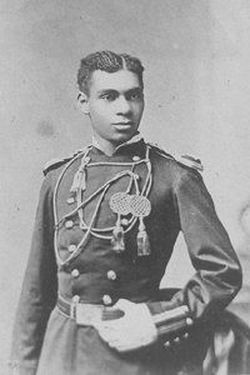 Henry O. Flipper's historical claim to fame is that he was the first African-American to graduate from West Point. But his story says a lot about lingering prejudices.
Henry O. Flipper's historical claim to fame is that he was the first African-American to graduate from West Point. But his story says a lot about lingering prejudices. Flipper was born into slavery in Thomasville, Georgia, on March 21, 1856 and was educated once the Emancipation Proclamation freed him and his parents.
In 1873 he received an appointment to attend West Point. He was not the first black student: there were four other black cadets already attending when he came.
The small group had a difficult time at the academy, where they were rejected by white students. In his 1878 autobiography, The Colored Cadet at West Point, Flipper describes how white professors and cadets refused to speak with him. Faced with social ostracism, he had to be content with "a pleasant chat every day, more or less, with the bugler, the tailor, the barber, and other workers at the school.
In spite of the isolation, Flipper persevered. In 1877, he became the first African American to graduation from West Point and earned a commission as a second lieutenant in the U.S. Army cavalry. He was assigned to Company A of the 10th Cavalry Regiment, which was one of four all-black "buffalo soldier" regiments. He arrived at Ft. Davis, Texas in 1880, where he was the quartermaster and commissary officer.
Until now, all-black regiments had been commanded by white officers. Flipper was the first black officer to command regular troops in the U.S. Army. It appeared that all of Flipper's perseverance was paying off. He seemed to be doing well, and was even praised for his performance during the Victorio War, a short skirmish with the Chihennes Apaches that ranged through southern New Mexico and Texas and spilled over into Mexico.
But Flipper's rise took an unexpected downturn in August of 1881, when he was arrested on suspicion of embezzling funds. Flipper had discovered a shortage of $1,440 in the accounts and instead of reporting it, lied about it. Flipper later testified that he believed the deficit was because of a mistake on his part, and he had determined to make it up over time out of his own monies. His court martial decided that inexperience and carelessness led to the deficiency and, even though the judge advocate general of the army determined that Flipper had not intended to defraud the government, he received a dishonorable discharge from the army in 1882.
In 1976, thirty-six years after his death, Flipper's heirs, requested that his case be reviewed. The Army then issued a certificate of honorable discharge in light of the fact that white officers found guilty of similar charges remained in service, while Flipper did not. It appears Henry O. Flipper was the victim of 19th Century racial prejudice.
Published on February 09, 2016 12:36
January 30, 2016
Crafty like Hec
 When Hector Anderson meets the new girl at school in Tweet Sarts, he falls head over heels.
When Hector Anderson meets the new girl at school in Tweet Sarts, he falls head over heels.What's a 7th grade boy to do? If you're Hec, you do something creative to impress her.
Hec marched to the student council snack bar. He set his cookies on the counter so he could shove his hand into his pocket. “Twelve packs of M&Ms, please,” he said.
Mrs. Darling, the guidance counselor, was tending the snack bar. She peered over the top of her little half glasses and her nostrils flared in disapproval. Hec wondered if she, too, was really some kind of alien invader. She certainly had never been a teenager herself.
Hec slapped the remainder of the lunch money Mom had given him on the counter. All six dollars of it.
“Surely you don’t plan to eat all twelve packages, Hector,” said Mrs. Darling.
“No ma’am!” Hec shoved the pile of crumpled bills forward.
“You’re not buying for all your friends? You know you can’t buy friendship, don’t you?”
“No ma’am. They’re for a project I saw in a Martha Stewart magazine.”
Mrs. Darling leaned over the counter and gave Hec an alien death stare. “You expect me to believe that you read Martha Stewart magazines, Hector? What are you really planning to do with these M&Ms? Shoot them from straws? Pretend they’re pills and swallow them whole? Crush them in the bleachers? Drool in Technicolor during biology? Go ahead and tell me: I’ve heard it all before.”
“Really!” Hec’s voice cracked so many times the word came out as four syllables in four different octaves. “My mom sometimes leaves her magazines in the bathroom so I look at them when I’m . . .” Hec’s voice cracked like static on a short wave radio. This was not the sort of thing he was used to talking about with women. He decided to skip the gory details and get right to the important part. “I’m gonna make roses with chopsticks. Uhm, in a basket. These are the centers. And there’s tissue paper petals!”
Mrs. Darling shook her head and handed over the candies. “Honestly, Hector. If you used half this much brainpower on your homework you’d be at Harvard by now, a child prodigy on a full scholarship.” But Hec wasn’t listening. He had his candies and was plotting his next step.
And what was Hec's next step? Just like he had said, it was a bouquet of roses for Sandy.
Hec's inspiration gave me inspiration. I thought it would be great publicity if I created a bouquet like Hec's and posted it on Pinterest. Why, I told myself, I could get a friend to film me making the flowers and post it on YouTube. The video would go viral! People all over the country would be making bouquets like Hec's! I could become a YouTube and Pinterest sensation!
So I went to the supermarket and bought supplies. I took them home and laid them out on the kitchen counter.
And proceeded to make a mess.
Two hours later, I had a large pile of wadded up tissue paper. I had a basket filled with pink and red somethings, with M&M centers. I wouldn't call them flowers. And I wouldn't post them on YouTube. Or Pinterest.
 Martha Stewart can breathe a sigh of relief. I am not going to be the next YouTube Crafts Queen, and my Pinterest post is not going to be featured in everyone's February feeds.
Martha Stewart can breathe a sigh of relief. I am not going to be the next YouTube Crafts Queen, and my Pinterest post is not going to be featured in everyone's February feeds.But maybe, just maybe, my bouquet is whimsical and earnest enough to win the heart of a 7th grade girl.
Which is, after all, why it was created in the first place.
Published on January 30, 2016 16:04
January 11, 2016
New Year, Same ol' Me
 By Torsten Henning [Public domain] via Wikimedia Commons For many people a new year is a time for a new beginning. We make resolutions, go on diets, begin new projects and swear that we will be better people than we were last year.
By Torsten Henning [Public domain] via Wikimedia Commons For many people a new year is a time for a new beginning. We make resolutions, go on diets, begin new projects and swear that we will be better people than we were last year. I vowed that I would be more organized this year. I would plan ahead, and then act on those plans so that my life would run more smoothly.
I didn't have to wait long to see how my new plan was going to go. My resolution faced its first challenge on the first Saturday of the year, which also happened to be the second day of the year.
On that particular day, I had planned an 8 mile training hike to help me and my team of middle schoolers and their parents get ready for the Bataan Death March Memorial Marathon on March 20. (I'll write another blog on this event if people show interest.) I knew I'd be coming back tired, so I planned to have dinner ready in advance. I loaded the bread machine with ingredients and set the timer. I loaded the crockpot with the makings of split pea soup (one of my favorite uses for a leftover ham bone! Thanks, sister Wendy for the Christmas ham!) Out the door I went, confident that all was organized and I would come back to a house filled with wonderful aromas.
The house did smell good when I got home, but smelling and looking are not always the same. Although I had set the timer on the bread machine, I had not pushed the pan down, seating it firmly into the mechanism that mixes and kneads the dough. The machine had diligently cooked the bread without mixing the ingredients, and so I had a flat, hard brick of whole-wheat something, with a layer of yeast on top and a layer of liquid at the bottom. Cheapy me couldn't even salvage the mess by cutting it into squares and turning it into croutons.
And the crockpot: I am sad to report that it was a no-go, as well. I had plugged it in. I had turned the dial. What I hadn't noticed was that the dial had split, and so even though the dial turned, the metal stem beneath it did not. The crockpot was as cold as it had been when I left three hours before.
Vince Lombardi said "It's not whether you get knocked down, it's whether you get up." I tossed the cold, hard peas and the hot, hard flour brick in the trash and reloaded both machines. By dinner time the house smelled good, and I had made good on my morning of stumbling around the kitchen. And the next Saturday I loaded both machines up right before heading out for a 10 mile hike.
I'm going to stumble a lot more in the new year. I'm probably going to lose important papers, forget appointments, write abysmally bad chapters, hurt someone's feelings, eat a whole bag of tortilla chips and who knows what else. If you're not failing, you're not trying. But I'll keep getting up and trying to redeem myself and the year.
How about you? Got any resolutions to keep? I'd like to know what they are and how you're doing with them. What resolutions have you made for 2016? * lose weight exercise more read more Other (tell me below!) If Other please specify: * So far, how are you doing on your resolution? * pretty good, but not perfect. resolution? What resolution? Would you like to hear more about the Bataan Marathon? * Not really interested. Submit
Published on January 11, 2016 09:12
January 4, 2016
Sandy's Cookies
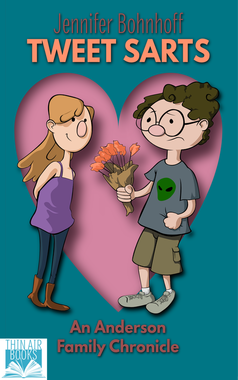 They say the way to a man's heart is through his stomach.
They say the way to a man's heart is through his stomach. Although Hec fell for Sandy at first sight, there's no denying that her cookies played a part in winning his eternal devotion.
Here's the recipe for the cookie that won Hec's heart:
Sandy's Cookies
3/4 cup firmly packed brown sugar
1/2 cup softened butter
1/2 shortening
2 tsp. vanilla
1 egg
1 2/4 cup flour
1 tsp baking soda
1/2 tsp salt
1 cup candy coated chocolate pieces (such as M&Ms)
1/2 cup chopped pecans
Preheat oven to 375.
Beat brown sugar, butter and shortening until light and fluffy.
Add vanilla and egg. Beat well.
Stir in flour, baking soda and salt.
Stir in candies and nuts.
Drop by teaspoonfuls 2 inches apart onto an ungreased cookie sheet.
Bake for 8-10 minutes until light golden brown (unless you're Sandy, and then you can burn them a bit.). Cool 1 minute before removing from cookie sheet onto rack to cool completely.
Hec and Sandy are characters in Jennifer Bohnhoff's newest middle grade novel, Tweet Sarts: An Anderson Family Chronicle, which is now available to preorder as an ebook and will be available in ebook and paperback starting on January 15th.
Published on January 04, 2016 08:24
January 2, 2016
New Year's Resolutions, Revisited
I just ran across my resolutions for 2015. They were:
1.Publish On Fledgling Wings in the spring. (which I managed to accomplish!)
2.Publish Swan Song this summer. (which I kind of did. No sooner had I gotten everything in place but a colleague convinced me that I didn't want to accomplish this goal. Beowulf is coming out as a major TV series (This month in Britain, next fall in the U.S.). It is supposed to be the next big thing: the next Game of Thrones. This colleague convinced me that I would have a better chance of selling a lot of copies if I waited until the series, so that when people Googled Beowulf, they would also find my book. Is she right? We'll find out this fall!)
3. Finish Summer of the Bombers by the time I go back to school in August. (never even touched Summer of the Bombers. This midgrade contemporary novel about a girl whose family falls apart after a forest fire destroys her home remains a half-finished manuscript. Perhaps I'll pull it out this year.)
4.Begin research on a new book to write next fall. (This I did, and with gusto. The book is Valverde, a middle grade novel set in the Civil War in New Mexico. Valverde is the story of two boys: a gentle animal lover from Texas and an Hispanic New Mexican who do not want to go to war but find themselves on opposite sides in the largest Civil War battle in the Southwest.
So, where do I go from here? In 2016, I plan
1. To publish a short, fun contemporary middle grade novel in January. (the first of the Anderson Chronicles.)
2. To write a teacher's guide for The Bent Reed
3. To complete a first draft of Valverde
4. To work on a Civil War Cookbook that will be a companion to The Bent Reed and Valverde and will come out at the same time as Valverde.
5. To really create a big publishing event for Swan Song in the fall.
6. Maybe finish Summer of the Bombers?
7. To publish a second Anderson Chronicle late in the year.
Can I do all this? I don't know, but I can try!
1.Publish On Fledgling Wings in the spring. (which I managed to accomplish!)
2.Publish Swan Song this summer. (which I kind of did. No sooner had I gotten everything in place but a colleague convinced me that I didn't want to accomplish this goal. Beowulf is coming out as a major TV series (This month in Britain, next fall in the U.S.). It is supposed to be the next big thing: the next Game of Thrones. This colleague convinced me that I would have a better chance of selling a lot of copies if I waited until the series, so that when people Googled Beowulf, they would also find my book. Is she right? We'll find out this fall!)
3. Finish Summer of the Bombers by the time I go back to school in August. (never even touched Summer of the Bombers. This midgrade contemporary novel about a girl whose family falls apart after a forest fire destroys her home remains a half-finished manuscript. Perhaps I'll pull it out this year.)
4.Begin research on a new book to write next fall. (This I did, and with gusto. The book is Valverde, a middle grade novel set in the Civil War in New Mexico. Valverde is the story of two boys: a gentle animal lover from Texas and an Hispanic New Mexican who do not want to go to war but find themselves on opposite sides in the largest Civil War battle in the Southwest.
So, where do I go from here? In 2016, I plan
1. To publish a short, fun contemporary middle grade novel in January. (the first of the Anderson Chronicles.)
2. To write a teacher's guide for The Bent Reed
3. To complete a first draft of Valverde
4. To work on a Civil War Cookbook that will be a companion to The Bent Reed and Valverde and will come out at the same time as Valverde.
5. To really create a big publishing event for Swan Song in the fall.
6. Maybe finish Summer of the Bombers?
7. To publish a second Anderson Chronicle late in the year.
Can I do all this? I don't know, but I can try!
Published on January 02, 2016 14:53
December 18, 2015
Silly Songs, Sweet Sentiments, Serious History
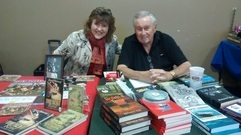 The author and Richard Peck selling our wares At the five craft fairs I worked at this fall, I sold not only my books, but CDs by the Sukey Jump Band. There a number of good reasons why.
The author and Richard Peck selling our wares At the five craft fairs I worked at this fall, I sold not only my books, but CDs by the Sukey Jump Band. There a number of good reasons why.
 Heidi Swedberg, my talented sister. One reason is that the lead of the Sukey Jump Band is my sister, Heidi Swedberg. If you can't sell for your sister, who can you sell for?
Heidi Swedberg, my talented sister. One reason is that the lead of the Sukey Jump Band is my sister, Heidi Swedberg. If you can't sell for your sister, who can you sell for?Another reason is that her CDs are really good. The Sukey Jump Band plays a mix of old, familiar songs and some originals, which are great for kids of all ages.
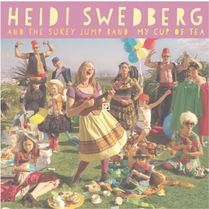 But there are other reasons. Her My Cup of Tea CD has a song entitled Johnny Martin, which is an old song that Abraham Lincoln is known to have sung to his own sons.
But there are other reasons. Her My Cup of Tea CD has a song entitled Johnny Martin, which is an old song that Abraham Lincoln is known to have sung to his own sons.Look closely, and you will see Daniel Ward behind Heidi, on the left. He's wearing a Civil War cap.
 That is a good tie-in to my novel, The Bent Reed. Set in Gettysburg, this historical novel is based on events that actually happened. I read numerous journals, diaries and Army reports to construct the background events that happen, and all but the central characters are historical.
That is a good tie-in to my novel, The Bent Reed. Set in Gettysburg, this historical novel is based on events that actually happened. I read numerous journals, diaries and Army reports to construct the background events that happen, and all but the central characters are historical.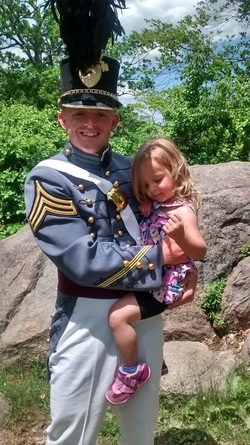 My son and granddaughter But a final reason is that in the liner notes, Heidi dedicates the song to soldiers, especially her nephew. She's referring to my son John, who graduated from West Point this spring and is now at Fort Benning. Selling Heidi's CD gives me an excuse to have John's portrait on the table so that I can brag about both my talented sister and my dedicated son. Wish you had a copy of My Cup of Tea? Post a picture of yourself with a copy of The Bent Reed on Facebook or Twitter and tag me so I'll see it. You could be one of three lucky people to win a copy of this great CD.
My son and granddaughter But a final reason is that in the liner notes, Heidi dedicates the song to soldiers, especially her nephew. She's referring to my son John, who graduated from West Point this spring and is now at Fort Benning. Selling Heidi's CD gives me an excuse to have John's portrait on the table so that I can brag about both my talented sister and my dedicated son. Wish you had a copy of My Cup of Tea? Post a picture of yourself with a copy of The Bent Reed on Facebook or Twitter and tag me so I'll see it. You could be one of three lucky people to win a copy of this great CD.
Published on December 18, 2015 11:17
November 25, 2015
Samuel A. Lockridge, Civil War SCALAWAG
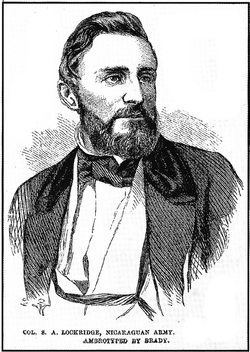 I meet a lot of interesting people doing research for historical fiction writing. Right now I’m working on a first draft of Valverde, a middle grade novel set in New Mexico during the Civil War. I’ve come across many colorful characters.
I meet a lot of interesting people doing research for historical fiction writing. Right now I’m working on a first draft of Valverde, a middle grade novel set in New Mexico during the Civil War. I’ve come across many colorful characters. The one who’s of interest to me right now is Samuel A. Lockridge, or at least that’s the name he was using when he was involved in the Civil War.
Born in 1829, he was known as William Kissane in the 1850s, when he was a partner in the merchant firm of Smith and Kissane in Cincinnati, Ohio. In 1852 Kissane took out an insurance policy on a steamship named Martha Washington and its cargo. Soon thereafter the ship, its cargo, and sixteen people aboard it burned, and Kissane was charged with conspiracy. He posted $10,000 in bail, then disappeared.
Around 1855 Kissane reappeared in Texas, but by now he was known as Samuel Lockridge. He joined forces with William Walker, an American physician, lawyer, journalist and mercenary, who gave him the rank of Colonel in his private army. Lockridge contributed $40,000, a considerable sum in those days, to help Walker recruit and equip a private military expedition into Latin America. Their intention was to establish an English-speaking colony under Walker’s personal control, an enterprise then known as "filibustering." Lockridge took 283 “Texas Rangers” to Nicaragua in late November of 1856, and was able to help Walker usurp the presidency of the Republic of Nicaragua. After a series of setbacks and several disagreements with Walker, Lockridge returned to Texas in August 1857. Soon thereafter, Walker was defeated by a coalition of Central American armies. The government of Honduras executed him in 1860.
Once back in Texas, Lockridge joined the Knights of the Golden Circle, a secret Southern society that advocated the extension of Southern institutions into new territory. He was not a delegate during the Convention that debated Texas secession, but he carried dispatches from Howell Cobb, the President of the Confederate Congress.
Lockridge joined the Fifth Texas Cavalry, one of the divisions in Sibley’s Army of New Mexico in July 1861 and became a Major. By that fall, Sibley's army was on the march. Their battle cry, "On to San Francisco!" showed their intention to take New Mexico as a stepping stone to the gold fields of Colorado, and the ports and gold of California. If Sibley would have succeeded, the Confederate States might have had the the prestige they needed to gain European allies and the capital to support their army better.
A few nights before the Battle of Valverde, Lockridge was sitting around a campfire with his men, and one of them sang “The Homespun Dress,” a Confederate song about how much a southern woman would be willing to sacrifice for the cause. Lockridge bragged that he was going to pull down the Union flag from Fort Craig. He said that if he could get a wife as easily as he was going to get the flag, then he would never sleep by himself again, and he planned to make a dress out of the flag to present to his wife.
On February 21, 1862 at the battle of Valverde, Lockridge led an assault on a battery of Union artillery. He and his men managed to cross the 800 yards between the Confederate line and the guns. He laid his hand on the muzzle of one of the cannons and shouted “This one is mine!” before being shot dead.
 THE HOMESPUN DRESS
THE HOMESPUN DRESS by Carrie Belle Sinclair
(born 1839)
Oh, yes, I am a Southern girl, And glory in the name, And boast it with far greater pride
Than glittering wealth and fame.
We envy not the Northern girl Her robes of beauty rare,
Though diamonds grace her snowy neck
And pearls bedeck her hair.
CHORUS: Hurrah! Hurrah! For the sunny South so dear; Three cheers for the homespun dress The Southern ladies wear!
The homespun dress is plain, I know, My hat's palmetto, too; But then it shows what Southern girls For Southern rights will do.
We send the bravest of our land To battle with the foe,
And we will lend a helping hand-- We love the South, you know
CHORUS
Now Northern goods are out of date; And since old Abe's blockade,
We Southern girls can be content With goods that's Southern made.
We send our sweethearts to the war; But, dear girls, never mind--
Your soldier-love will ne'er forget The girl he left behind.--
CHORUS
The soldier is the lad for me-- A brave heart I adore;
And when the sunny South is free, And when fighting is no more,
I'll choose me then a lover brave From all that gallant band;
The soldier lad I love the best Shall have my heart and hand.--
CHORUS
The Southern land's a glorious land, And has a glorious cause;
Then cheer, three cheers for Southern rights, And for the Southern boys!
We scorn to wear a bit of silk, A bit of Northern lace,
But make our homespun dresses up, And wear them with a grace.--
CHORUS
And now, young man, a word to you: If you would win the fair,
Go to the field where honor calls, And win your lady there.
Remember that our brightest smiles Are for the true and brave,
And that our tears are all for those Who fill a soldier's grave.--CHORUS
from
http://www.civilwarpoetry.org/confederate/songs/homespun.html
Published on November 25, 2015 08:37
November 16, 2015
Good inspiration for bad times
 The view out my front door. TIt’s snowing outside: lovely flakes that are just now sticking to the road and making me hopeful for a two hour delay tomorrow. (Note: Us teachers NEVER wish for a snow day; those have to be made up. We fervently wish for a two hour delay, because most of us know we can just talk a little faster and get the same amount of work out of our wiggly 7th graders. It’s a win-win.)
The view out my front door. TIt’s snowing outside: lovely flakes that are just now sticking to the road and making me hopeful for a two hour delay tomorrow. (Note: Us teachers NEVER wish for a snow day; those have to be made up. We fervently wish for a two hour delay, because most of us know we can just talk a little faster and get the same amount of work out of our wiggly 7th graders. It’s a win-win.)I have the flu right now. Yesterday I had chills and fever and stayed in bed, covered with every blanket in the house, for most of the day.
For most people, snow and the flu are bad things. For a writer, they’re just that more inspiration.
Right now I’m working on my Civil War Novel set in New Mexico, and one of my main characters, Jemmy Martin, is enroute between San Antonio and El Paso with General Sibley’s 3,200-man Army of New Mexico. Jemmy is a packer, a civilian who was hired at $1.25 a day to manage the army pack trains that carried ammunitions and rations because enlisted men either would not or could not properly learn to pack. (Very few packers ever got paid, and when they did, it was in worthless Confederate scrip.)
Jemmy’s huddled with other men around a fire made with green mesquite. The thorns keep puncturing his benumbed fingers and the saddle blanket around his shoulders isn’t keeping out the cold or the blowing snow, but he’s better off than a lot of soldiers. Because he rides with the pack train, Jemmy has access to the tents and blankets and food supplies. Many a soldier’s diary complains about stopping for the night far from where the train stops and having nothing more than what they had carried.
Sibley lost about 500 men during this 500 mile march. While some men were transferred or deserted, the majority of the loses came from small pox, measles, and pneumonia. Having the chills makes me think that perhaps I need to write a “sick scene” into my novel. Although flu isn’t mentioned in Civil War accounts, it is entirely possible that some of the other diseases, most notably black measles, could have been the flu.
So I sit here, feet up on the hearth, a fire roaring, drinking spiced cider and thinking up mean scenarios to put poor Jemmy Martin through. Cold. Snow. Disease. Poor Jemmy better pray we don’t have an earthquake here. Neither he, nor my historical novel, would like that.
Published on November 16, 2015 16:20



